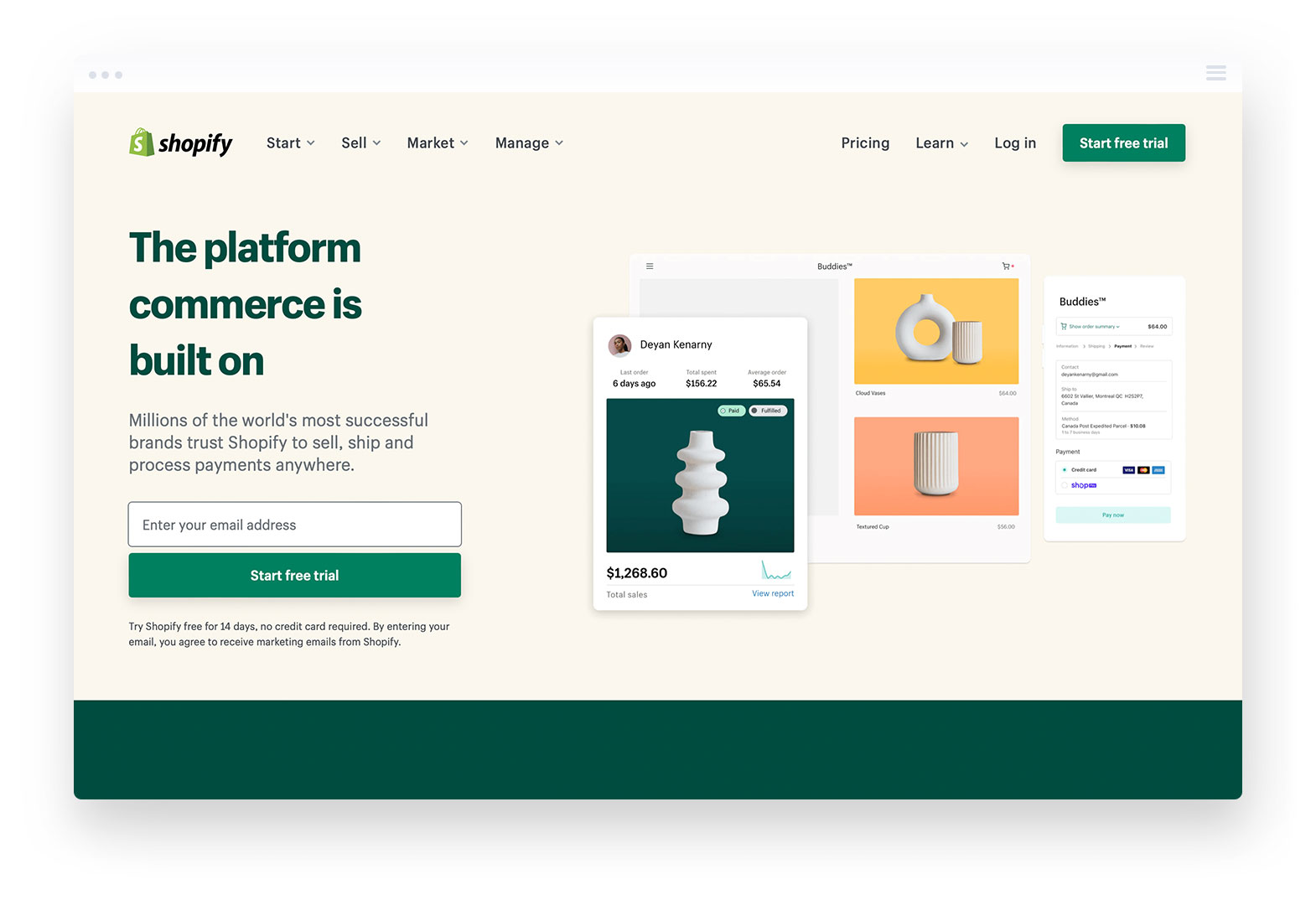Is a Custom WooCommerce Store or Shopify Theme Best for Your Business in 2024?
Choosing the right ecommerce platform for your online store can be a daunting task, especially when faced with the two giants of the industry: WooCommerce and Shopify. In this “WooCommerce vs Shopify” comparison, both platforms have their ardent followers, but how do you know which is the right fit for your business? We will explore the nuances of the WooCommerce vs Shopify debate by examining their respective features, pricing structures, customization options, user-friendliness, and more. This comprehensive analysis will guide you to a well-informed decision, ultimately revealing which platform takes the crown in the WooCommerce vs Shopify showdown..
Key Takeaways to Compare a Shopify Store and WooCommerce Store
- Comparing WooCommerce vs Shopify in 2024 requires careful consideration of pricing, customization capabilities, and user-friendliness, which is crucial.
- WooCommerce offers more control over costs and greater flexibility/customization. While Shopify provides an easy setup process for do-it-yourselfers with limited control and potential additional costs.
- We’ll look at real-world examples and testimonials can provide helpful insight to determine the best platform for a business based on its requirements, preferences and resources.

WooCommerce and Shopify are among the most popular eCommerce platforms available today, powering millions of online stores worldwide. WooCommerce, an open-source plugin for WordPress, focuses on flexibility and customization, making it an ideal choice for businesses with web development resources. In contrast, Shopify, a hosted platform, offers a user-friendly interface and a streamlined experience that is perfect for small businesses and entrepreneurs without technical expertise who prefer to do it themselves.
Both WooCommerce and Shopify command significant popularity, with data from Google Trends suggesting a slight preference for Shopify. However, the choice between these platforms ultimately depends on your individual needs and proficiency and the availability of themes, plugins, and other features.
What is WooCommerce?
WooCommerce is an open-source eCommerce store plugin for WordPress, providing flexibility and customization for businesses with web development capabilities. Unlike Shopify, WooCommerce is a self-hosted eCommerce solution, requiring you to acquire a web hosting account and domain name and manage your online store independently. However, this also means that WooCommerce offers greater freedom and adaptability, making it a popular choice for larger businesses and developers who prefer to have full control over their web store.
Despite being a free plugin, WooCommerce does come with additional costs, such as domain and hosting fees, as well as the price of any extra extensions. Nevertheless, WooCommerce remains the most widely used eCommerce platform, powering 28% of the top 1 million websites, compared to Shopify’s 20%.
What is Shopify?
Shopify, on the other hand, is a hosted eCommerce platform that delivers a user-friendly interface and hassle-free experience, making it an ideal choice for small businesses and those without technical expertise. Unlike WooCommerce, Shopify takes care of the technical aspects, such as hosting, themes, and plugins, all included in its monthly pricing plans, allowing you to focus on growing your business.
Despite its ease of use, Shopify is not without its drawbacks. Limited control and potentially high costs due to transaction fees and additional features may deter some users. However, with a vast user and developer base, Shopify provides invaluable support and a powerful app ecosystem, making it a strong contender in the eCommerce industry.

Key Factors to Consider When Choosing Between WooCommerce and Shopify
-
When deciding between WooCommerce and Shopify, there are three key factors to consider: pricing, customization capabilities, and user-friendliness. Each platform has unique features, benefits, and drawbacks in these areas, making it essential to weigh your options carefully before committing to one.
Pricing & Costs
Regarding pricing, WooCommerce and Shopify offer distinct structures for your online store. While WooCommerce is free, additional costs are associated with web hosting, domain names, and security. Also, certain regional and less popular payment gateways may require fees. However, the flexibility of WooCommerce allows you to search for cost-effective hosting and theme prices, giving you more control over your expenses.
In contrast, Shopify offers set monthly pricing plans ranging from $9 to $299. Shopify Payments, the platform’s built-in payment gateway, does not charge transaction fees. The fees depend on your Shopify plan if you choose a third-party payment provider. They range from 2% for Basic Shopify to 1% for Shopify and 0.5% for Advanced Shopify. Although Shopify’s pricing is more straightforward, it can become costly if you require additional features or external payment gateways.
Ultimately, the choice between WooCommerce and Shopify in terms of pricing will depend on your budget and business requirements. WooCommerce allows for more control over costs, while Shopify provides a simpler pricing structure with the potential for higher expenses due to additional features and transaction fees through the eCommerce store.
business grows.

Customization and flexibility are crucial factors to consider when choosing an e-commerce platform. WooCommerce, an open-source platform, offers unlimited potential for customization, making it a top choice for larger businesses with web developers. WooCommerce offers the ability to tailor your online store to your exact preferences and requirements, providing a unique shopping experience for your customers.
On the other hand, Shopify offers a more streamlined experience with fewer customization options. While it does provide a thoughtfully curated collection of themes and a user-friendly interface, it may not be suitable for businesses that require extensive customization or flexibility. Shopify may be the better option for those who prioritize ease of use over customization and control.
Ease of Use & Setup
Ease of use and setup is also vital when selecting an e-commerce platform, particularly for those with limited technical expertise. Shopify excels in this area, providing a simple setup process and an intuitive user interface that allows you to focus on growing your business. With Shopify, you can quickly build and manage your online store, making it an attractive choice for small businesses and entrepreneurs.
Conversely, WooCommerce can be more complex, especially if it’s your first WordPress website. It requires installing and configuring both WordPress and the WooCommerce plugin, which can be time-consuming and challenging for those without prior experience. However, if you are familiar with WordPress or have access to web development resources, the added flexibility and customization of WooCommerce may outweigh the initial setup challenges.

WooCommerce vs Shopify: Platform Features Comparison
So far, we’ve examined the pricing, customization, and ease of use of WooCommerce and Shopify. Next, we’ll compare the features offered by each platform, including themes and design, payment options, and inventory management.
A thorough examination of these features will provide a clearer insight into the platform that best matches your business needs.
Themes & Design
When it comes to themes and design, both WooCommerce and Shopify offer a variety of options. WooCommerce users enjoy a wider range of WooCommerce themes and design options, allowing for increased customization and flexibility. With its open-source nature, WooCommerce allows you to create a unique online store that caters to your needs.
In contrast, Shopify features a curated selection of sales-optimized Shopify themes that offer a more refined design experience. Although Shopify’s themes are of high quality, they may not provide the same level of customization as WooCommerce. Shopify may be the better choice for businesses that prioritize design quality and consistency out of the box, but for those who value flexibility and customizability, WooCommerce is the way to go, as you can hire a professional web designer to craft a custom WooCommerce site for your business.
Payment Options
Payment options are another critical factor to consider when choosing an eCommerce platform. WooCommerce supports a variety of payment gateways, giving you the freedom to choose the one that best suits your business needs. Unlike Shopify, WooCommerce does not impose a percentage fee on transactions, which can be a significant advantage for businesses looking to minimize costs.
On the other hand, Shopify Payments offers its own payment gateway, which does not charge transaction fees. However, depending on your chosen plan, additional fees may apply if you choose to use an external payment gateway. While this can result in higher costs, Shopify’s built-in payment system simplifies the payment process and provides a more streamlined experience for merchants and customers.
Inventory Management & Product Variations
WooCommerce and Shopify offer inventory management features, allowing you to manage your online store’s stock and product variations efficiently. However, there are some differences in the capabilities of each platform. While WooCommerce provides extensive customization options and flexibility in managing inventory and can be integrated with enterprise-level ERP systems, Shopify has certain limitations on integrations and product variations.
Despite these limitations, Shopify offers comprehensive control over inventory management with features such as:
- Stock tracking
- Stock alerts
- Automated purchase orders
- Revenue reports
Both platforms can handle inventory management and product variations, but the choice between them will depend on your specific business needs and preferences.

Scalability & Growth Potential
As your business grows, you’ll need an e-commerce platform to accommodate increased traffic and sales for your eCommerce store.
WooCommerce for Larger Businesses
WooCommerce offers greater customization and scalability options for larger businesses with web developers and designers. As an open-source platform, it provides full control over your WordPress site, allowing you to:
- Adjust and expand your online store as needed
- Add custom features and functionality
- Integrate with third-party tools and services
- Optimize your site for performance and SEO
This flexibility makes WooCommerce an attractive choice for businesses with specific requirements and growth plans.
Nonetheless, it’s crucial to consider the extra costs and responsibilities that come with managing a self-hosted platform. For larger businesses with the resources to handle these tasks, WooCommerce can offer a powerful and adaptable e-commerce solution.
Shopify for Smaller Businesses
On the other hand, Shopify is more suitable for smaller businesses requiring a user-friendly and streamlined experience. With its hosted platform, Shopify handles the technical aspects of your online store, giving you peace of mind in terms of performance, security, and scalability. You can upgrade your Shopify plan to accommodate increased traffic and sales as your business expands.
While Shopify may not offer the same customization and flexibility as WooCommerce, its ease of use and comprehensive features make it an attractive option for small businesses and entrepreneurs looking to establish and grow their online presence.

SEO & Marketing Capabilities
Search engine optimization (SEO) and marketing capabilities are essential for driving organic traffic and increasing sales in your online store. Both WooCommerce and Shopify offer strong tools and features in this regard, but there are some notable differences between the two platforms.
WooCommerce, built on a dedicated blogging platform, offers SEO-optimized code and seamless integration with WordPress and its vast selection of WordPress plugins. This enables you to customize page meta descriptions and titles, providing clear information for search engines and improving your online store’s visibility. More advanced SEO features, such as schema markup are available through free plugins, like RankMath.
Shopify has certain limitations when it comes to SEO. These include a rigid URL structure and the inability to modify certain sections of the store URLs. However, Shopify does offer a range of SEO plugins available in its Shopify App Store, as well as features that simplify the process of adding basic SEO information to your store.
In terms of marketing capabilities, both WooCommerce and Shopify provide:
- Account creation and guest checkout options
- Affiliate and referral systems
- Integration with popular email marketing platforms such as MailChimp and Constant Contact
Choosing the two platforms will ultimately depend on your specific marketing needs and strategies.

Security & Support
Securing your online store and offering adequate customer support is key to building trust and nurturing lasting business relationships. When comparing WooCommerce and Shopify regarding security and support, it’s clear that each platform has its own strengths and weaknesses.
Shopify provides the following features and support:
- Built-in SSL and PCI-DSS compliance to protect customers’ sensitive data during transactions
- 24/7 customer support through live chat, phone, email, and Twitter
- Comprehensive documentation, how-to guides, a knowledge base, video tutorials, and forums
On the other hand, WooCommerce, as a self-hosted platform, requires you to manage security independently or through your hosting provider. Regular website maintenance on any platform is paramount to securing your site. While WooCommerce does offer 24/7 phone and live chat support, most of the security measures are the responsibility of the user, such as:
- Obtaining an SSL certificate
- Configuring security plugins
- Implementing two-factor authentication
- Achieving PCI compliance
Despite these added responsibilities, WooCommerce is a secure and reliable platform when managed correctly.

Migration & Integration
For businesses contemplating a transition between WooCommerce and Shopify, considering migration and integration options is vital for a seamless transition. Fortunately, tools such as Cart2Cart and LitExtension can help facilitate data migration between the two platforms.
These tools allow you to transfer a wide range of data, such as order IDs, product descriptions, SKUs, and more, ensuring that your online store remains functional and consistent during migration. Utilizing these migration tools can minimize downtime and potential losses, making the transition between WooCommerce and Shopify as seamless as possible.
Ultimately, your specific business requirements, preferences, and resources will dictate the choice between WooCommerce and Shopify. While WooCommerce may be more suitable for larger businesses with web developers, Shopify can provide an ideal solution for smaller businesses looking for a user-friendly and streamlined platform.

The WooCommerce vs Shopify Comparison Summarized
WooCommerce and Shopify have unique features, benefits, and drawbacks, making the choice between the two platforms highly dependent on your specific business needs and preferences. WooCommerce offers greater flexibility and customization, making it a better fit for larger businesses with web development resources, while Shopify provides a user-friendly interface and streamlined experience, which is ideal for small businesses and those without technical expertise. By carefully considering the factors discussed in this blog post, such as pricing, customization, ease of use, and scalability, you can make an informed decision and select the e-commerce platform that best aligns with your business goals.
Frequently Asked Questions about Shopify vs WooCommerce
WooCommerce and Shopify offer great solutions for creating an online store, with WooCommerce having the edge due to its ease of use and more advanced customization features. Ultimately, it depends on your individual needs and preferences.
Overall, WooCommerce is more affordable than Shopify when starting out. The basic cost for WooCommerce is $2.75 per month compared to Shopify’s $9.00 minimum fee. However, the cost of WooCommerce can go up with paid extensions or if you choose to hire a web designer and developer to create a custom WooCommerce site.
WooCommerce offers a customizable platform for experienced developers, while Shopify, due to its user-friendly interface and streamlined experience, is ideal for small businesses without technical expertise.




